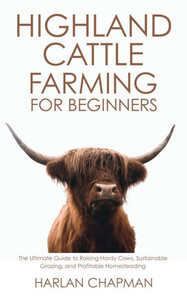
Highland Cattle: The Ultimate Guide To Raising Highland Cattle For Beginners: Sustainable Grazing, Breeding, Homestead Beef Production, And Profit Str
Independently published
ISBN13:
9798280542457
$16.65
Known for their distinctive appearance with their long, broad horns and long, wavy coat, Highland cattle are a unique breed that holds an important place in agriculture. Originally from Scotland, they have a centuries-old history and remain highly valued for their resilience, adaptability and premium meat. Highland cattle have become a symbol of the Scottish Highlands. Their hardy nature and ability to thrive in harsh climates make them a critical asset to modern agriculture. This introduction provides an overview of highland livestock farming, examining its history and origins and examining its importance in contemporary agriculture.1. Overview of the highland livestockHighland cattle are a hardy, hardy breed of cattle native to the Scottish Highlands. They are best known for their long, shaggy fur, which comes in a variety of colors including black, red and yellow. One of the most distinctive features of highland cattle is their long, broad horns that curve outward and upward from the head. In addition to being visually striking, these cattle are known for their resilience, especially in harsh environments where other cattle may struggle to survive.The Highland breed is a small to medium-sized breed of cattle whose bulls typically weigh between 1,200 and 1,500 pounds and cows between 800 and 1,100 pounds. They have a strong, sturdy build that allows them to handle a variety of terrain, from uneven slopes to wet moorland. Their long hair provides excellent protection from the cold and wet weather conditions common in the Scottish Highlands.Highland cattle are best known for their meat, which is considered to be of high quality. Due to the cattle's slow growth and grass-based diet, the beef is lean, flavorful and tender. However, these cattle are also valued for their role in sustainable agriculture, conservation grazing and their ability to thrive in low-input systems. Their hardiness combined with a calm temperament makes them an ideal choice for farmers looking for a low-maintenance, environmentally friendly breed.While the Highland breed is best known for its beef production, it also plays a key role in maintaining biodiversity. Many farmers use highland cattle for conservation grazing, a technique that helps protect native flora and fauna by controlling invasive species while creating grazing pressure that allows native plants to thrive.2. History and originsThe origins of Highland cattle can be traced back to the rugged terrain of the Scottish Highlands, where they have been part of the landscape for over a thousand years. The breed is one of the oldest in Europe and is believed to have descended from ancient Celtic cattle introduced to Scotland by early settlers. These cattle were well adapted to the harsh conditions of the Highlands, where food was scarce and the weather unforgiving. Over time, they developed their special characteristics, such as their long fur that protected against cold and their ability to graze coarse vegetation.The first documented record of Highland cattle dates back to the 16th century, although the breed is believed to have existed long before that time. Early highland cattle were smaller than modern cattle and were probably used as draft animals or for milk production. However, over time the focus shifted to beef production and the breed's meat quality improved.In the 18th century, Highland cattle began to attract more attention outside Scotland because they were known for their hardiness and the excellent quality of their meat. They were introduced to other parts of the United Kingdom and eventually to other countries such as Australia, New Zealand and the United States, where they were valued for their adaptability and ability to thrive in different climates.In the late 19th century, Highland cattle became established as a popular breed in the United Kingdom and abroad.
- | Author: Adams Leo
- | Publisher: Independently Published
- | Publication Date: Apr 19, 2025
- | Number of Pages: 00110 pages
- | Binding: Paperback or Softback
- | ISBN-10: NA
- | ISBN-13: 9798280542457
- Author:
- Adams Leo
- Publisher:
- Independently Published
- Publication Date:
- Apr 19, 2025
- Number of pages:
- 00110 pages
- Binding:
- Paperback or Softback
- ISBN-10:
- NA
- ISBN-13:
- 9798280542457





